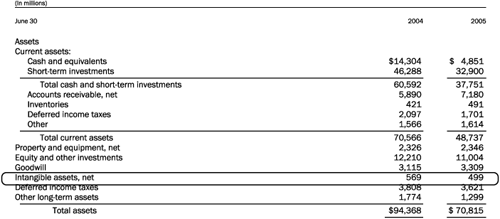Intangible Assets
Intangible assets comprise nonphysical acquired assets and include:
Brand
Franchise
Trademarks
Patents
Customer lists
Licenses
Goodwill
These intangible assets are items that have value based on the rights belonging to that company.
Intangible Assets Are Typically Recognized Only When AcquiredUnder U.S. GAAP the value of internally developed intangibles cannot be accurately quantified and recorded (think back to Coke, General Electric, Microsoft). Companies are not permitted to assign values to these brand names, trademarks unless the value is readily observable in the market (via an acquisition). |

IFRS Perspective: Certain Internally Generated Intangible Assets RecognizedRecall that U.S. GAAP requires research and development (R&D) expenses, which can often be associated with the creation of internally generated intangible assets, to be expensed on the income statement. The IFRS allows development costs, when certain criteria are met, to be capitalized (on the balance sheet) and amortized (on the income statement) over their useful life. |
Intangible Assets Are Linked to Amortization on the Income Statement
Recall that amortization is the systematic allocation of intangible assets over an estimated useful life. Intangible assets are reduced on the balance sheet via amortization on ...
Get Crash Course in Accounting and Financial Statement Analysis, Second Edition now with the O’Reilly learning platform.
O’Reilly members experience books, live events, courses curated by job role, and more from O’Reilly and nearly 200 top publishers.

